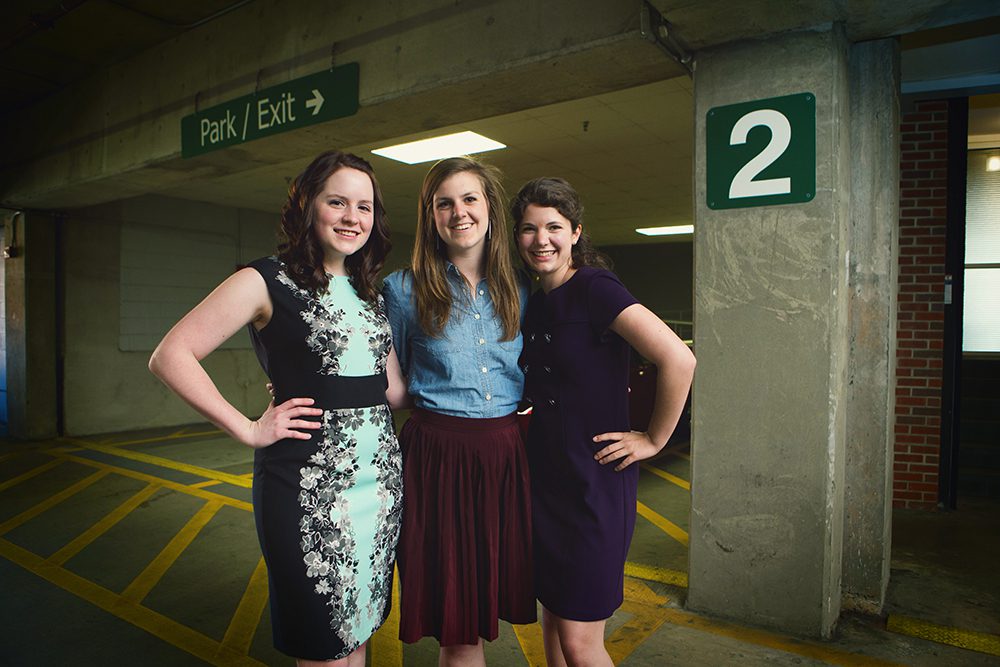Math in the city

By Erikah Haavie
With 10 city-owned garages and more than 7,000 spaces, the logistics of parking in Greenville can be tricky.
“Downtown Greenville is rockin’ and rollin’,” said Mike Murphy, Greenville’s Director of Public Works for past nine years. “It’s a constant chess game.”
But the city now has a new partner in finding parking solutions for downtown businesses, a trio of Furman math majors.
Beth Bleed and Elise Prete ’13 and Kelly Cercy ’15 got their inspiration from a conference they attended with seven other Furman students and math professor Liz Bouzarth in January 2012.
While attending the Nebraska Conference for Undergraduate Women in Mathematics in Lincoln, they heard about a University of Nebraska course, “Math in the City,” which put students to work to analyze the best location for building a new police station in the city.
The course got students thinking about what they could do to take math out of the classroom and, at the same time, provide a service to the Greenville community. So they sat down with city officials, including city manager and Furman alum John Castile, to brainstorm ideas.
The student-driven effort resulted in a new applied mathematics course, the first of its kind at Furman, taught by Bouzarth and professors Kevin Hutson, Sarah Frick, and John Harris.
With the help of Geographic Information System mapping software and integer programming software, students are analyzing the efficiency of the current parking downtown and looking at possible ways to optimize use of available space. The goal is to provide a parking space for employees and business owners within reasonable walking distance, Bouzarth said.
“Parking is an essential element to a successful downtown, and we want our businesses, visitors, and residents to have easy experiences parking here,” said Mary Douglas Hirsch, Greenville’s Downtown Development manager. “The city views an effective parking system part of our overall ‘downtown package,’ and having enough parking offered at reasonable rates is critical to our business recruitment and retention efforts.”
While the project is currently a pilot independent study course, if all goes well, it could become a formal math course in the future, Bouzarth said.
The project has been a challenging one, but one students have been eager to tackle.
Students have each taken a portion of the project, gathering information, building databases of downtown businesses and turning addresses into latitudes and longitudes. It’s meant lots of data-crunching, correspondence with city officials, and trips downtown to verify distances and locations. They’re meeting three times a week to share information and consult with faculty and each other.
“It’s been so interesting to see how government runs, down to the nuts and bolts,” said Bleed of Wheaton, Ill. “It’s been great to have a chance to apply what I’ve been learning.”
Cercy, a native of North Augusta, plans to continue her research over the summer with support of the Furman Advantage program.
“I knew I loved math and had a passion for it,” she said.
Furman’s “Math in the City” course has not only helped her to get to know Greenville better, but it’s helped her know how to use her math skills in a practical way to serve the community, Cercy said.
Douglas Hirsch said she hopes there will be more opportunities for Furman and the City of Greenville to collaborate in the future.
“We have always been very impressed with the high caliber of students at Furman and their critical thinking skills,” she said. “We hope projects like these will integrate Furman students further in the Greenville community and will entice them to stay here after graduation. Furman students make great young professionals, and Greenville certainly wants as many of them as possible to start and grow their careers here.”